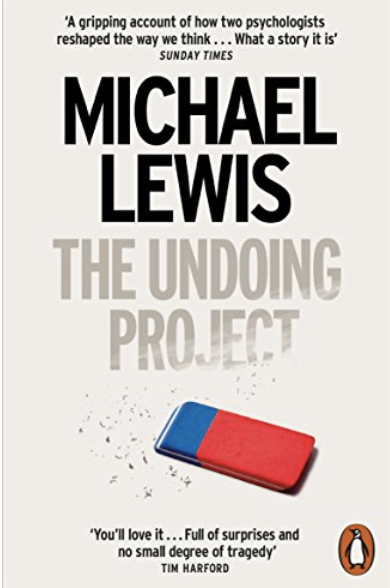Lewis, Michael. The Undoing Project. Penguin Books. 2017. Print.
One project Michael Lewis undoes in his 2016 book The Undoing Project is his own best-seller Moneyball. In their review of Lewis’s 2003 book, economist Richard Thaler and legal theorist Cass Sunstein argued that the scouting mistakes Lewis explored were well-documented biases of human judgment and decision-making. The work documenting those systematic errors had just earned Daniel Kahneman a Nobel Prize in Economics in 2002. Lewis had never heard of Kahneman or Kahneman’s collaborator Amos Tversky, who had died in 1996. The Undoing Project shows Lewis offering a richer explanation for the phenomena documented in Moneyball by telling the story of Tversky’s and Kahneman’s relationship, explaining the ideas their research uncovered, and surveying the impact that research has had in fields ranging from medicine to economics and, yes, even sports.
Lewis makes the relationship and collaboration between Kahneman and Tversky the core of the book. The two men met in the late 1960s in Tel Aviv, where they were professors at the Hebrew University. Kahneman was a depressive émigré from France, where he and his family had survived the Nazi occupation because his father was a beloved chemist for L’Oréal. Tversky had grown up in Israel, but his roots were in Eastern Europe, where his grandfather, like Kahneman’s, had been a rabbi. Both Kahneman and Tversky fought for the Israeli army. Kahneman had cut his psychological teeth designing a diagnostic for military leadership that essentially “moneyballed” leadership assessment avant la lettre and which the Israeli army uses to this day (one of Lewis’s many tidbits is that the army tried to improve Kahneman’s test, made it worse than changed it back). Tversky was physically brave (he was a paratrooper) and by all accounts the smartest man his contemporaries had ever met, someone who inspired the theorem that your intelligence was directly related to how quickly in conversation with Amos you realized he was smarter than you were. Kahneman was the artist, Tversky the mathematician. Kahneman was the man of self-doubt, Tversky the man of self-confidence. Kahneman was the one who noticed his own proclivity for systematic error in the areas of judgment, prediction, and decision-making, Tversky was the rigorous scientist able to show how Kahneman’s failings were how everyone’s brain worked.
The paper Kahneman and Tversky wrote on “Prospect Theory” almost single-handedly created behavioral economics.
Those three terms—judgment, prediction, and decision-making—offer a short-hand introduction to Kahneman and Tversky’s groundbreaking research, which took as its aim the “undoing” of a widely-held view of human nature. They showed that because we tend to follow certain heuristics or rules of thumb, we are easily fooled by certain cognitive illusions, thus undercutting psychological and economics theories which assume we are fundamentally rational and statistically oriented. Moreover, when it comes to taking our judgments and making predictions, we are also handicapped in our ability to make statistically-correct predictions. We tend to leap from small data samples to huge conclusions, and this is particularly true of experts who are more likely to trust their gut than admit a complex situation’s uncertainty. Finally, Kahneman and Tversky showed that we are risk-averse when we make decisions in ways that are not entirely rational. Give us a sure gain (say, $500) versus a coin toss for nothing or even more money (say, $1000), and we’ll take the sure thing. Confront us with a sure loss or a coin toss for a loss of nothing or twice as much as the sure loss, and, more often than not, we’ll become risk-takers. The paper Kahneman and Tversky wrote on “Prospect Theory” almost single-handedly created behavioral economics.
Even as the pair split in the 1980s—a story which Lewis shows has all the emotional complexity of divorce—people like Don Redelmeier, Richard Thaler, and Darryl Morey made the pair’s work more well known. A salient feature of Kahneman and Tversky’s work was its accessibility. While the pair published numerous papers in peer-reviewed journals, they chose accessible forums like Science and Psychology for their widest-ranging work. As a result, others seized upon and used their findings in everything from improving medical diagnosis to scouting NBA drafts. A key feature of the Kahneman and Tversky style would be to give the reader a scenario similar to this one taken from Kahneman’s 2011 book Thinking, Fast and Slow.
“Steve is very shy and withdrawn, invariably helpful but with little interest in people or in the world of reality. A meek and tidy soul, he has a need for order and structure and a passion for detail.” Is Steve more likely to be a librarian or a farmer?
In short, they invite readers to make a mistake. The description matches a stereotypical librarian, but since there are 20 male farmers for every 1 male librarian, Steve is far more likely to be the former, no matter how quickly a picture of Steve sitting behind a circulation desk pops into your mind. Tversky and Kahneman showed readers their own intuitive errors and, in this way, invited a whole host of practitioners to begin undoing cognitive biases in their own fields.
The Undoing Project is itself exceptionally written. Lewis’s books are more like his own than anyone else’s. He’s a fantastic storyteller, and he has access here to a collaboration that’s as personal as any romance and as compelling as any buddy comedy. One of the insights Kahneman and Tversky made is that we are more likely to engage with stories than we are numbers, and Lewis finds in the story of these men who discovered important ideas the very way of communicating their ideas. No, the book is not as thorough in explaining Tversky and Kahneman’s research as, say, Thinking, Fast and Slow, but in returning to Kahneman’s book, I’ve found that Lewis’s biographical details and contextual framing have made Kahneman’s already compelling analysis leap off the page.
Sadder to me than the Lennon-McCartney-esque split between Kahneman and Tversky is that both men made their atheism clear. The spiritual ramifications of their work are left unexplored, even as their work hints at cognitive problems we are born with, systematic cognitive errors that are connected to the deadly sin of pride. The work Tversky and Kahneman do is rooted in experiments more than theory, which is admirable, and stems from Kahneman’s keen sense of fallibility, which is more admirable still. Yet, the faith of his father teaches that it is the fool who says in his heart, “There is no God.” A penchant for disbelief? That’s the most damning bias.

